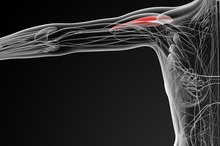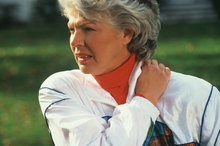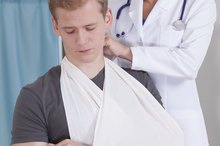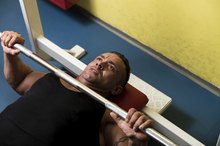Rehab for a Broken Collarbone After Surgery
A collarbone break or fracture is a common injury. The collarbone is also known as the clavicle and is the bone that connects your arm to your body. Most broken collarbones are treated non-surgically by immobilizing your arm in a sling for several weeks. If your collarbone is displaced, or out or normal alignment, surgery is required. Rehab after surgery helps you regain normal motion of your arm and shoulder.
Early Recovery
After clavicle surgery to correct a displaced fracture, your only rehab concern is to keep your arm relatively still in an arm sling or a figure of eight wrap. The wrap is like a sling but wraps around your body and gives your arm, shoulder and collarbone more support. Your doctor will monitor your healing for the first six to eight weeks after surgery before prescribing physical therapy exercises. You can use the affected arm for simple everyday accomplishments like bathing, eating and getting dressed, but restrict your movements as much as possible. Do not lift, reach, push, pull or stretch with the affected arm.
- After clavicle surgery to correct a displaced fracture, your only rehab concern is to keep your arm relatively still in an arm sling or a figure of eight wrap.
Stretching Exercises
Strengthening Exercises to Recover from a Fractured Humerus
Learn More
Collarbone surgical repair rehab continues with stretching exercises. Under your doctor's supervision, you may be able to start this phase of rehabilitation approximately eight weeks after the procedure. Rehab may include range of motion exercises like shoulder shrugs, pendulum swings and shoulder flexion. Shoulder shrugs should be completed without hand weights in this stage. To perform a pendulum swing, support yourself with your healthy arm on placing your palm on a table or heavy piece of furniture. Slowly swing your injured arm as far forward as you can, and then backward, stopping if you experience significant pain. Shoulder flexions are done by placing your injured arm next to a wall. Your hand should face your body and your forearm should come in contact with the wall. Slowly slide your arm up the wall until your upper arm also touches the wall. Slide as high as you can without pain.
- Collarbone surgical repair rehab continues with stretching exercises.
- To perform a pendulum swing, support yourself with your healthy arm on placing your palm on a table or heavy piece of furniture.
Strengthening Exercises
Strengthening exercises for rehab are appropriate for most clavicle fracture patients to begin about three months after surgery. This type of rehab helps you regain the strength you have lost during recovery from the fracture and subsequent surgery. Arm curls work your bicep and tricep muscles and can be completed with hand weights ranging from two to five pounds, depending on your overall strength and condition. Keep your arm extended fully, grip the weight and bend your arm as much as you can without pain. Hold the position for 10 seconds before releasing. Chest raises are usually part of a rehab program post-clavicle alignment surgery. Lie on your stomach with your arms straight at your sides. Raise your chest off the ground and hold for five seconds. This exercise is to be done without using your hands and is not the same as a pushup.
- Strengthening exercises for rehab are appropriate for most clavicle fracture patients to begin about three months after surgery.
- This exercise is to be done without using your hands and is not the same as a pushup.
Considerations
Exercising with a Deltoid Strain
Learn More
With physical therapy, you will see improvement in your range of motion and a lessening of your discomfort, but total recovery time from a clavicle alignment can span a number of months. If your fracture is severe, you may still not be operating at full capacity for as long as nine months to a year as you continue to heal.
Related Articles
References
- Your Orthopaedic Connection; Clavicle Fracture; January 2011
- Sports Science Orthopaedic Clinic; Clavicle Fracture; 2011
- Söyüncü S, Bektaş F, Cete Y. Traditional Kehr's sign: Left shoulder pain related to splenic abscess. Ulus Travma Acil Cerrahi Derg. 2012;18(1):87-8. doi:10.5505/tjtes.2011.04874
- Villa-Forte A. Musculoskeletal Pain. Merck Manual Consumer Version. 2019.
- Clavicle Fracture (Broken Collarbone). American Academy of Orthopaedic Surgeons.
- Shoulder Trauma (Fractures and Dislocations). American Academy of Orthopaedic Surgeons.
- Rotator cuff problems. US National Library of Medicine. 2019.
- Thoracic Outlet Syndrome. Johns Hopkins Medicine.
- Andreacchio A, Marengo L, Canavese F. Condensing osteitis of the clavicle in children. World J Orthop. 2016;7(8):494-500. doi:10.5312/wjo.v7.i8.494
- Anyfantakis D, Kastanakis M, Karona P, Fragiadakis G, Kokkinos I, Bobolakis E. Spontaneous rupture of the spleen masquerading as a pulmonary infection. Case Rep Surg. 2014.
- Broken Collarbone (Clavicle Fracture). TeensHealth from Nemours. 2018.
- Magnetic Resonance Imaging (MRI) - Musculoskeletal. Radiological Society of North America. 2019.
- Lee KJ, Jung K, Kim J, Kwon J. Bone scan as a screening test for missed fractures in severely injured patients. Orthop Traumatol Surg Res. 2014;100(8):953-957.
- Infections After Fracture. American Academy of Orthopaedic Surgeons.
- Andreacchio A, Marengo L, Canavese F. Condensing osteitis of the clavicle in children. World Journal of Orthopedics. 2016;7(8):494-500. DOI: 10.5312/wjo.v7.i8.494.
- Ashley A. Weaver, Jennifer W. Talton, Ryan T. Barnard, Samantha L. Schoell, Katrina R. Swett & Joel D. Stitzel(2015). Estimated Injury Risk for Specific Injuries and Body Regions in Frontal Motor Vehicle Crashes, Traffic Injury Prevention. 16:sup1, S108-S116. DOI: 10.1080/15389588.2015.1012664.
- Freischlag J, Orion K. Understanding Thoracic Outlet Syndrome. Scientifica. 2014;2014:248163. DOI: 10.1155/2014/248163.
- Murphy RJ, Carr AJ. Shoulder pain. BMJ Clinical Evidence. 2010;2010:1107.
- SACCOMANNO MF, DE IESO C, MILANO G. Acromioclavicular joint instability: anatomy, biomechanics and evaluation. Joints. 2014;2(2):87-92.
- Sergent SR, Johnson SM, Ashurst J, Johnston G. Epstein-Barr Virus-Associated Atraumatic Spleen Laceration Presenting with Neck and Shoulder Pain. The American Journal of Case Reports. 2015;16:774-777. DOI: 10.12659/AJCR.893919.
Writer Bio
Erica Roth has been a writer since 2007. She is a member of the Society of Professional Journalists and was a college reference librarian for eight years. Roth earned a Bachelor of Arts in French literature from Brandeis University and Master of Library Science from Simmons College Graduate School of Library and Information Science. Her articles appear on various websites.









